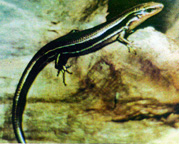|
| 질의: green lizard | 결과: 141번째/148 | |
Coal Skink (Eumeces anthracinus) - Wiki
| 제목: | Coal Skink (Eumeces anthracinus) - Wiki
| |

| 해상도: 179x144
파일크기: 28013 Bytes
등록시간: 2007:01:24 09:29:24
|
Coal Skink
From Wikipedia, the free encyclopedia
[Photo] Coal Skink. From the U.S. Army Corps of Engineers.
The Coal Skink (Eumeces anthracinus) is a North-American lizard that grows to 13 to 18 cm (5 - 7 inches) in length with a maximum snout to vent length of 7 cm (2.75 inches). It is a four-lined skink whose light stripes extend onto the tail. The broad dark lateral stripe is 4 - 4.5 scales wide and there are no light lines on top of the head. The dorsolateral light stripe is on the edges of the 3rd and 4th scale rows, counting from midline of back. One postmental scale is present. The sides of the head of the male are reddish during spring breeding season, at least in some parts of the range.
Taxonomy
There are two subspecies of the Coal Skink:
- Northern Coal Skink (Eumeces anthracinus anthracinus)
- Southern Coal Skink (Eumeces anthracinus pluvialis)
The (Northern) Coal Skink has first been described by Baird in 1850; the southern subspecies E.a. pluvialis was identified by Cope in 1880.
The Southern Coal Skink as a subspecies has posterior supralabials with light centers and dark edges, producing a spotted appearance. There are 26 or more rows of scales around the middle of the body.
Reproduction
The Coal Skink mates in spring or early summer, laying a clutch of 8 or 9 eggs. The young hatch after four to five weeks and are about 5 cm (2 in) long. The hatchlings have a blue tail; those of the Northern Coal Skink are striped like the adults, but young Southern Coal Skinks have black bodies with at the utmost faint traces of stripes.
Habitat and Range
The more humid portions of wooded hillsides with abundant leaf litter or loose stones are favorite habitats. Coal Skinks' habitat may also include areas around springs and rocky bluffs overlooking creek valleys. If pursued, they will not hesitate to take refuge in shallow water, going to the bottom and hiding under stones or debris.
The Northern Coal Skink (blue in the figure) occurs in western New York and central Pennsylvania and in isolated colonies in the Appalachians. The Southern Coal Skink (orange) can be found on the eastern Gulf coast from the Florida panhandle to Louisiana as well as west of the Mississippi from eastern Kansas and central Missouri to eastern Texas and northern Louisiana. Scattered intermingled occurrences of both species (green in the figure) occur in Alabama and in Georgia.
http://en.wikipedia.org/wiki/Coal_Skink
| The text in this page is based on the copyrighted Wikipedia article shown in above URL. It is used under the GNU Free Documentation License. You may redistribute it, verbatim or modified, providing that you comply with the terms of the GFDL. |
|
^o^
동물그림창고 똑똑전화 누리집
^o^
|
|